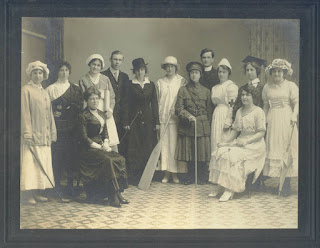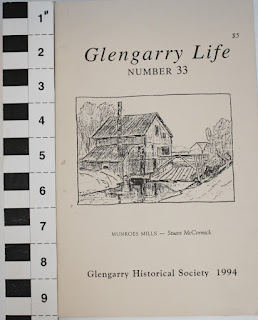Photo
of the St. Andrew’s Cross Garden, July 2023.
Patrons who have recently paid a visit to the
Glengarry Pioneer Museum over the past few weeks may have spotted two brand-new
additions to the museum’s grounds. Thanks to the fundraising efforts of the
Maxville Horticultural Society, leadership of Glengarry Pioneer Museum
volunteer and gardener, Allison Hall, and a handful of others, one new
interpretive garden signs and one reprinted garden sign have been installed at
two of the museum’s Heritage Gardens. These signs will introduce visitors to
the flowers and many different medicinal and culinary plants and herbs that
grow in the Rose Garden, located south of the Loyal Orange Lodge, and the St.
Andrew’s Cross Garden, located north of the Star Inn near the Dunvegan village
crossroads.
This
photo of the Star Inn depicts the current location of the St. Andrew’s Cross
Garden as it would have appeared in the late 1980s. Object ID: 2011-000-071.
The diverse variety of the herbs and plants that can
be found in the museum’s Heritage Gardens have either been donated by families
living in the Glengarry area, or they have been obtained from heritage plant
sources such as Upper Canada Village and other suppliers. Many pioneer
households would have grown an array of plants and herbs in areas that were
easily accessible to the kitchens, or summer kitchens, of the family residence.
Plants and herbs were not only widely used for culinary purposes, but also for
their dyeing and medicinal properties when access to healthcare or physicians
would have been rare for those who lived in rural communities like the early
inhabitants of the Glengarry area.
Chamomile
in bloom in the St. Andrew’s Cross Garden in July 2023.
One such plant that is currently in bloom in the St.
Andrew’s Cross Garden and featured on the garden’s new interpretive sign is
Chamomile. This plant, also known by its botanical name, Chamaemelum Nobile,
would have been routinely used by pioneers in the Glengarry area for medicinal
purposes. Chamomile is a member of the daisy family, known as Compositae,
and has its origins in Europe and North America where it is grown wild
and cultivated in sunny and well-drained sites. Its white flowers contain an
aromatic oil that were at one time used for both their anti-inflammatory and
antiseptic properties. For instance, a tea could be made by steeping the flower’s
petals to soothe the stomach, however the flower itself would have been used as
a topical antiseptic as well.
Photograph
of Growing Herbs and Plants for Dyeing (1977) by Betty E. M. Jacobs and
Illustrator Kathleen Gough for the Glengarry Pioneer Museum’s reference library.
Object ID: 2009-000-191.
Among other plants and herbs featured in our Heritage
Gardens, Chamomile would have also been used as a natural textile dye by
pioneers in the Glengarry area. Betty E. M. Jacobs details dyeing instructions
that approximate the textile dyeing processes pioneers may well have implemented
in Growing Herbs and Plants for Dyeing (1977) from the Glengarry Pioneer
Museum’s reference book collection. This source reveals how Chamomile was commonly
used to dye textiles with pigments from the plants’ flower petals, which would
have been an accessible source of pigment to 19th century pioneers.
Dyer’s Chamomile, also known as Golden Marguerite and
Oxeye Chamomile, is a Chamomile cousin of the variety grown at the museum by
the botanical name of Anthemis Tinctoria. Unlike the white
flowers of its cousin’s variety, this plant produces golden-yellow, daisy like
flowers that bloom from stiff stems between late summer and early fall. Pioneers
would have harvested this Chamomile variety while it was in full bloom to make
use of their golden-yellow flower petals as a natural dye for wool in either dried
of fresh form. The dye would have been combined with a mordant to fix the
pigment in the wool textile. A mordant of alum would produce a yellow/buff
colour, a chrome mordant would produce a golden/orange colour and a tin mordant
would produce a clear yellow colour.
Photo of the new interpretive St. Andrew's Cross Garden sign north of the Star Inn (above), and the reprinted Rose Garden sign south of the Loyal Orange Lodge (right) from July, 2023.
During your next visit, the Glengarry Pioneer Museum invites
you to enjoy the summer blooms of the St. Andrew’s Cross Garden, and to learn
about the countless culinary, medicinal, and dyeing uses of all the plants and
herbs growing in our Heritage Gardens with our new interpretive garden signs. Special
thanks to the Maxville Horticultural Society for their donation towards this
project, and to Glengarry Pioneer Museum volunteer and gardener, Allison Hall,
whose garden knowledge, and leadership brought our garden signs to life.


%20McLeod%20Store.jpg)




.png)





